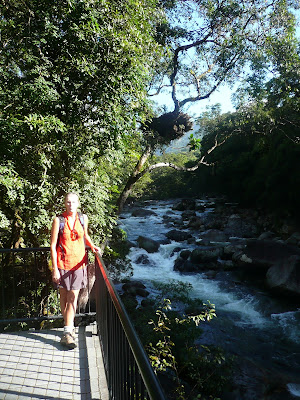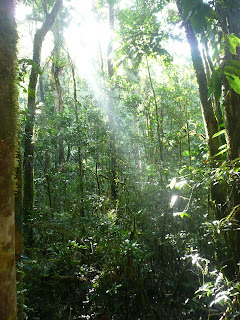We had heard much about the Mossman Gorge. "You just must see" ...."it is spectacular"...."words can't describe it" etc, etc. Well now it was time to see for ourselves. My only problem after our tramp around the 2 km track, which is the longest of the gorge walks, was to edit the dozens and dozens of photos I took. There are surprises around every bend.
I suspect this will be one of the most 'pictorial' blogs I ever present. There are occasions when words are superfluous.
The gorge is managed entirely by local aboriginal folk who staff the information and interpretive centre (read also café, souvenir shop) at the main car park. At the risk of sounding suspiciously patronising, but with not a whiff of that intention, I must comment that the staff with whom we dealt in obtaining our $6.00 shuttle bus tickets, maps and so on, were absolutely charming. Smart uniforms, beaming smiles and precise answers to questions asked augured well for the rest of the morning.
No private vehicles are allowed on the access road from the information centre to the beginning of the several trails which meander through the gorge. Visitors have a choice of the kilometre or so walk from the main centre or can take advantage of the electric shuttle buses which circulate every 15 minutes. We chose the bus on the basis of the fact we had already decided to do the longest of the gorge walks, and were duly deposited at the entrance to the gorge trails,
where not only are there a number of instructive hoardings and signs, but an adjacent picnic area of some considerable charm.
So, armed with our trusty map we set off. I have been struggling to work out how best to share the wonderful morning we had and have decided that any attempt to go 'step by step' along the various trails would be meaningless. I have chosen, rather, to present the gorge in pictorial chunks including the differing moods of the river, the rain forest, the trails and other odds and ends of interest (to us at least) in the hope that this provides an overall picture.
Let's begin with the trails. A couple of them are merely loops around, for example, one of the swimming holes. These are well paved and provide for comfortable walking with steps and formal walkways making access easy.
The two kilometre full gorge walk is a different matter. Given we could not be sure if we would ever be this way again, and the fact that the day of our visit was clear and sunny, the whole hog was a no-brainer. And what an experience.
The two kilometre full gorge walk is a different matter. Given we could not be sure if we would ever be this way again, and the fact that the day of our visit was clear and sunny, the whole hog was a no-brainer. And what an experience.
The trail varied in form almost from bend to bend. Some stretches were a doddle,
with or without steps
whilst others were a little more challenging.
Relatively open pathways were interspersed with rambles through areas where the forest crowded in on both sides.
One of the real features of the path in several spots was the manner in which large surface tree roots had be utilized as steps (more of tree roots later).
and, what trail can really stand up to scrutiny if it does not boast a suspension bridge. This was actually built by members of the Army Engineers as a community project. The components were manufactured off site and flown in by helicopter when the army chaps then hefted the bits into place and bolted it all together. And believe me, when walking across it there is no doubt it is 'suspended'...it wobbles in all directions.
Apart from the incredible rain forest, the main feature of the gorge is the Mossman River. It really is lovely. Even when not in sight through the dense undergrowth there are very few sections of the long walk when it cannot be heard bubbling and gurgling as it makes its way across its rocky bed. Interestingly it flows directly behind our caravan park, where its mood is substantially different, but more of that later.
As I mentioned at the outset, one of my more difficult tasks in presenting this blog was the application of editorial rigour in respect of the myriad of photos I took of the river. Hopefully, dear reader, this selection will enable you to share some of the beauty we experienced.
Our first glimpse was at this relatively wide, softly flowing section. The water was crystal clear and surprisingly warm. If you look closely you can see the stones on the river bed immediately below the largish rock on the left of the shot.
But its mood is ever changing, as in this spot where the small amount flowing off the ranges behind the gorge bustles its way across the granite stones of its water course.
In what always seems odd to us southerners, the flow at this time of the year, winter, is at its lowest and most benign.
Notwithstanding the fact that the La Nina season has brought much more winter rain to this part of the tropics, with daily falls of up to 50 mls on occasions, this is a mere spit compared to the downpours of the summer 'wet'.
Warning notices abound along the public areas of rivers such as the Mossman warning of the potentially dire consequences of entering the water during heavy rainfall periods, even if it is not actually raining locally. Similar to the warnings which caution folk not to camp in dry river beds in the Flinders Ranges lest they become victim to flash flooding from rain events of which they may not even be aware, this is the message here. In full spate this river, for example, can apparently rise many metres in a matter of minutes.
But today it was on its best behaviour, happy to please an amateur 'happy snapper' and his delightful model!
The fact that this is 'the dry' is clearly demonstrated here. This feeder rivulet is barely flowing at the moment. During the wet, this and many others like it, funnel torrents of water off the sides of the gorge into the main stream.
But it is not all 'look but don't touch' for the hot and bothered riparian adventurer. Quite close to the entrance car park is this charming 'designated' swimming hole where
a deeper, slow flowing section of the river is complemented by a naturally sandy 'beach' and a relatively broad open expanse of water. Mind you, I would not be too keen on a dip here during the wet when I am sure 'the surf would be up'!
And finally, two shots from the suspension bridge which show as clearly as any the manner in which the river can change its nature in a very short distance.
Upstream it tumbles over a shallow rocky bottom
and then immediately downstream of the bridge forms a series of pools and dams.
If culling the river photos for presentation was a challenge, it was equalled by that relating to the shots of the forest through which we roamed. Let my first disclaimer, or more correctly, admission of ineptitude, be to note that it was impossible to photographically capture the entire height of some of the enormous giants which inhabit this forest.

Typical of all rain forests, the competition for light is intense. Even the cycads, which we in SA would consider tall at, say, two metres, here can reach the dizzying heights of up to 30 metres where they present their fronded tops to the sun atop impossibly slender stalks. Two of these extraordinary 'ferns' can just be seen on the right side of this photo. These were probably about 20 metres from toe to tip.
No matter where one walks in these botanic powerhouses, the dank, musty smell of rotting vegetation is all pervasive. And, as could be expected in this environment, fungi abound.
It was during this walk that the importance of the root structure of many of the larger trees was highlighted and explained. As could be expected, the soil of a rain forest is perpetually moist, if not downright sodden. This phenomenon presents the larger trees with an engineering problem, namely, remaining upright, a condition which is pretty useful for arboreal survival.
Many have solved this problem in a quite spectacular way.....buttressing.....the term which describes the manner in which these trees develop huge, spreading root systems which provide support in all wind conditions.
Just as the types of trees vary considerably, so too does the manner in which they manage to anchor themselves securely to terra firma. We saw examples ranging from a comparatively fine network of roots
But we found the 'king daddy' of the buttress world almost at the end of our walk. This incredible tree had thrown buttress roots so large they were difficult to capture in one photograph. Apart from the fact that she graces all she touches, I had Liz pose beneath this forest behemoth in an attempt to provide some concept of scale.
Incredibly this tree displayed a decided lean. We are unsure if this is notwithstanding its enormous roots or whether these were the product of its quest for survival after it was potentially up ended.
We did learn later that the cyclones which beset this area have a beneficial effect on the rain forests. The trees which fall create a gap in the canopy through which light is then able to reach the forest floor and stimulate new and varied growth.
Another interesting fact we learnt was that the trees on the higher ridges do not actually need direct rainfall to acquire water. They can apparently 'harvest' moisture through their leaves at times when mist covers the canopy. Cunning organisms, trees!
And finally, we cannot leave our Mossman Gorge walk without reference to the very large granite boulders which are strewn hither and yon along the sides of the walking track. Despite the size of many of them, they seem to cower back in the forest gloom, almost unnoticed until one stubs one's toe!
Let me end where I began, with expressions of acclaim for the Mossman Gorge, but this time from us. We have certainly now joined that throng of Mossman Gorge advocates. It is spectacular.
With the benefit of hindsight I would venture that the Daintree Forest area, which we visited later, whilst different in some aspects, was no more appealing or interesting.
Another interesting fact we learnt was that the trees on the higher ridges do not actually need direct rainfall to acquire water. They can apparently 'harvest' moisture through their leaves at times when mist covers the canopy. Cunning organisms, trees!
And finally, we cannot leave our Mossman Gorge walk without reference to the very large granite boulders which are strewn hither and yon along the sides of the walking track. Despite the size of many of them, they seem to cower back in the forest gloom, almost unnoticed until one stubs one's toe!
Let me end where I began, with expressions of acclaim for the Mossman Gorge, but this time from us. We have certainly now joined that throng of Mossman Gorge advocates. It is spectacular.
With the benefit of hindsight I would venture that the Daintree Forest area, which we visited later, whilst different in some aspects, was no more appealing or interesting.
We are now back at Kurrimine Beach for a few weeks where I anticipate having the time to catch up blogwise, and where hopefully the photos will take less than the almost seven hours these did to load. Mossman, the township and surrounds in the next instalment.

























No comments:
Post a Comment